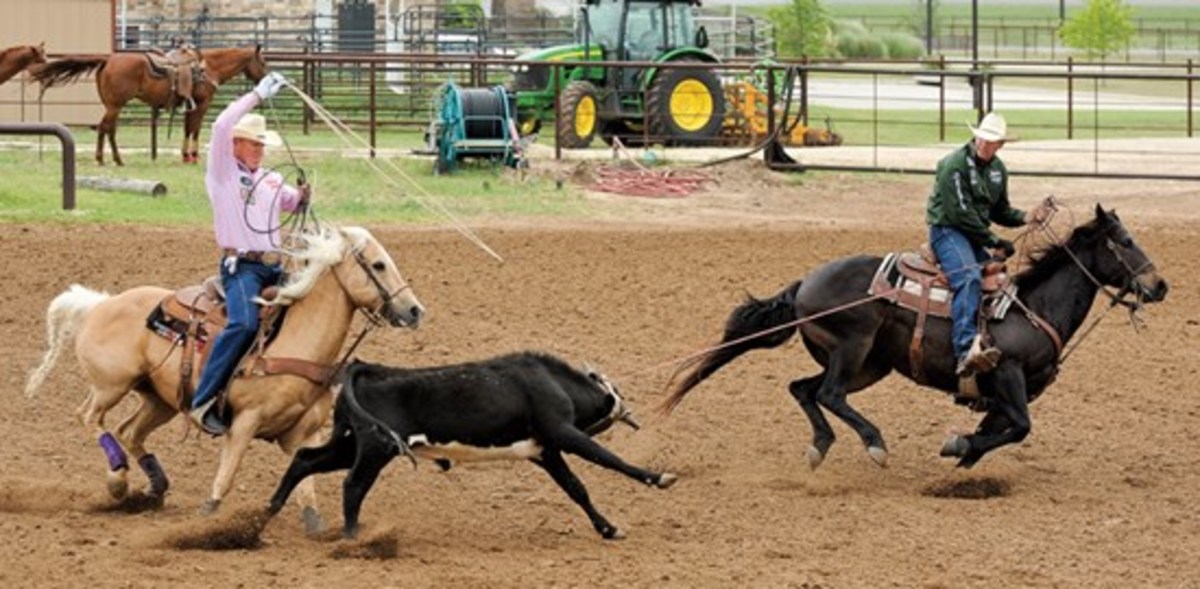The handling of the steer by the header is the time of the run where the team really comes together. The heeler is viewing how the header is picking the steer up in the corner and making the turn. The direction and speed of the steer, and the movement, timing and rhythm of the steer in the midst of the corner is all information the heeler is reading. By now I’ve made so many runs that if I see the head horse just drop out of there, I know the steer’s going to hit hard. When that happens it’s a little bit unpredictable what he’s going to do next. So it naturally makes me pause and wait a little bit, just to be sure that steer’s feet come together and that he’s going to lift up and show me a timing off of that hit.

That type of wild, unpredictable presentation causes a response from me. It doesn’t automatically mess up the run all that badly, but it does immediately make me pause. A guy who picks a steer up and keeps that steer’s momentum stride for stride all the way through the turn gives me an easier look. I can tell each stride is going to be the same based on that presentation, because I can tell that the motion and the rhythm isn’t going to change.
If a header gets a steer on a short, tight rope that tells me a lot about what’s going to happen. It tells me if I can come in aggressively, or if things are going to hit hard and I need to wait until that steer’s going to come up and out of there. If you watch roping a lot and watch the handles and teams make runs, it’s the smooth transition in the corner and the runs where the timing stays the same that consistency comes from. And that’s all in the setup from the header, basically.
The header’s job is one of the hardest jobs there is to do. There are just so many things that go into doing the job really well. The head horse that you’re riding and how easy he is to control in the corner—lots of things come into play in what a header can do with a steer.
If you’re roping older cattle that are half worn out you don’t have to pay as much attention to the handle. When you rope fresher, stronger cattle you need to really pay attention, because the slightest move affects everything and has an effect on what a steer’s going to do in the corner.
The main thing about a steer’s hind end that keeps those feet together and in good timing is if the header has a lot of control and pressure on a steer’s head. That was really perfected years ago back in California, when they had the Oakdale 10-Steer, Chowchilla Stampede 8-Steer and Riverside Rancheros 10-Steer ropings. Handling steers going fast was perfected at those ropings, because you have to handle steers right to be able to make 10 runs in a row. Nowadays, the art of doing that is not as well-defined, because roping has gotten so fast, and conditions and styles have changed so much.
Last year at the Spicer Gripp (Memorial Roping in Hereford, Texas), (producer) Steve Purcella had some old-school steers that were fleshy and strong and really ran. The roping was won with a leg, and third was won with a barrier or maybe a couple of legs. It wasn’t that the heelers were so terrible that day. I told everybody when I left that day that 15 years ago it would have been a much tougher roping, because the headers handled cattle differently. They came back up toward the chute more and kept more pressure on steers’ heads. Nowadays, the only time the steer’s on the end of the rope very good is in the turn. The pressure comes off the steer’s head a little bit right after that, and a strong steer will change his hop. That fakes the heeler out and makes that steer extremely hard to heel. The era of Jake Barnes, Tee Woolman, Charles Pogue, David Motes and Steve Purcella perfected that style of roping. Speed Williams came in behind them and was a reacher, but he figured the rest of it out to dominate at the jackpots, too. Everybody wants to just throw a lot of rope and step out in front of steers today. But you still have to keep that same pressure on their heads, because if you turn their heads loose they’re on their own. The Spicer Gripp roping was so amazingly easy because today’s style of roping didn’t fit there anymore. And there are just a few guys who know how to rope that style correctly these days. I’m not saying that there are not a lot of talented headers, because there are definitely more talented headers now than ever before. But there are only a few who know how to really handle a big, fresh steer.










